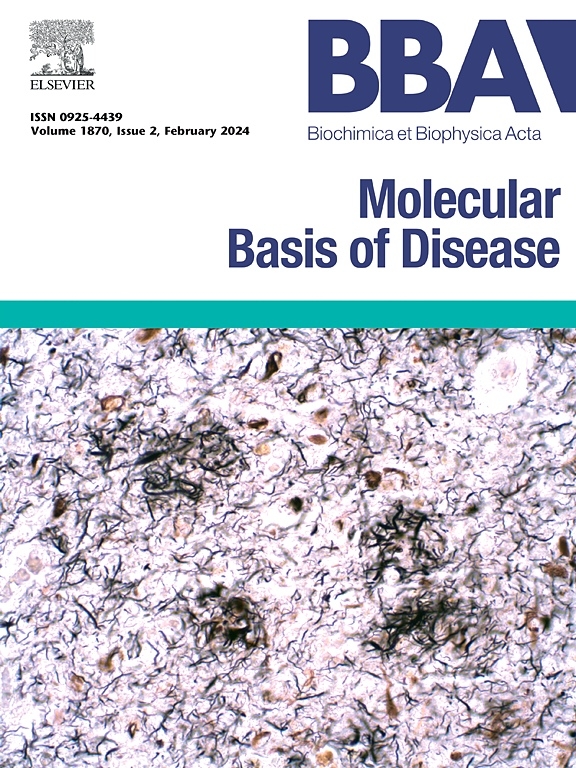FBXW8-mediated degradation of PPT1 suppresses epithelial-mesenchymal transition and metastasis in hepatocellular carcinoma
IF 4.2
2区 生物学
Q2 BIOCHEMISTRY & MOLECULAR BIOLOGY
Biochimica et biophysica acta. Molecular basis of disease
Pub Date : 2025-07-12
DOI:10.1016/j.bbadis.2025.167985
引用次数: 0
Abstract
Hepatocellular carcinoma (HCC) is a leading cause of cancer-related mortality, characterized by its aggressive growth, high metastatic potential, and resistance to therapeutic interventions. Dysregulation of the ubiquitin-proteasome system (UPS) is recognized as a hallmark of cancer; however, its precise functional contributions to HCC pathogenesis remain incompletely elucidated. In the present study, we identify F-box and WD repeat domain-containing 8 (FBXW8), an F-box protein component of the Cullin-RING ligase (CRL) complex, as a pivotal tumor suppressor in HCC. Through a combination of in vitro and in vivo models, we demonstrate that FBXW8 depletion facilitates HCC cell proliferation, migration, invasion, and epithelial-mesenchymal transition (EMT), whereas FBXW8 overexpression exerts inhibitory effects on these malignant phenotypes. Proteomic and mechanistic analyses reveal that FBXW8 targets palmitoyl-protein thioesterase 1 (PPT1), a lysosomal hydrolase, for ubiquitination and subsequent proteasomal degradation. Elevated PPT1 expression correlates with poor clinical prognosis in HCC patients and is positively associated with the activation of EMT and oncogenic signaling pathways. Our data further reveal that PPT1 promotes EMT in part by enhancing the expression of critical EMT transcription factors, notably Snail Family Transcriptional Repressor 1 (SNAIL) and Zinc Finger E-box Binding Homeobox 1 (ZEB1), with a more pronounced effect on SNAIL. Mechanistically, FBXW8-mediated degradation of PPT1 inhibits EMT, reducing metastatic potential, whereas PPT1 silencing reverses the tumor-promoting effects of FBXW8 loss. These findings establish the FBXW8-PPT1 axis as a pivotal regulatory pathway linking UPS-mediated proteostasis to HCC progression and metastasis. Our study highlights the therapeutic potential of targeting PPT1 or restoring FBXW8 activity to disrupt oncogenic signaling and improve outcomes in HCC patients.
fbxw8介导的PPT1降解抑制肝细胞癌上皮-间质转化和转移
肝细胞癌(HCC)是癌症相关死亡的主要原因,其特点是其侵袭性生长、高转移潜力和对治疗干预的抵抗。泛素-蛋白酶体系统(UPS)的失调被认为是癌症的标志;然而,其在HCC发病机制中的确切功能贡献尚未完全阐明。在本研究中,我们发现含有F-box和WD重复结构域8 (FBXW8), Cullin-RING连接酶(CRL)复合物的F-box蛋白成分,是HCC中的关键肿瘤抑制因子。通过体外和体内模型的结合,我们证明FBXW8的缺失促进了HCC细胞的增殖、迁移、侵袭和上皮间质转化(EMT),而FBXW8的过表达对这些恶性表型具有抑制作用。蛋白质组学和机制分析表明,FBXW8靶向棕榈酰蛋白硫酯酶1 (PPT1),一种溶酶体水解酶,用于泛素化和随后的蛋白酶体降解。PPT1表达升高与HCC患者临床预后不良相关,并与EMT和致癌信号通路的激活呈正相关。我们的数据进一步表明,PPT1促进EMT的部分原因是通过增强关键EMT转录因子的表达,特别是蜗牛家族转录抑制因子1 (Snail Family Transcriptional Repressor 1, Snail)和锌指E-box Binding Homeobox 1 (ZEB1),其中对Snail的作用更为明显。从机制上讲,FBXW8介导的PPT1降解抑制EMT,降低转移潜力,而PPT1沉默逆转了FBXW8丢失的促肿瘤作用。这些发现证实FBXW8-PPT1轴是连接ups介导的蛋白停滞与HCC进展和转移的关键调控途径。我们的研究强调了靶向PPT1或恢复FBXW8活性以破坏致癌信号并改善HCC患者预后的治疗潜力。
本文章由计算机程序翻译,如有差异,请以英文原文为准。
求助全文
约1分钟内获得全文
求助全文
来源期刊
CiteScore
12.30
自引率
0.00%
发文量
218
审稿时长
32 days
期刊介绍:
BBA Molecular Basis of Disease addresses the biochemistry and molecular genetics of disease processes and models of human disease. This journal covers aspects of aging, cancer, metabolic-, neurological-, and immunological-based disease. Manuscripts focused on using animal models to elucidate biochemical and mechanistic insight in each of these conditions, are particularly encouraged. Manuscripts should emphasize the underlying mechanisms of disease pathways and provide novel contributions to the understanding and/or treatment of these disorders. Highly descriptive and method development submissions may be declined without full review. The submission of uninvited reviews to BBA - Molecular Basis of Disease is strongly discouraged, and any such uninvited review should be accompanied by a coverletter outlining the compelling reasons why the review should be considered.

 求助内容:
求助内容: 应助结果提醒方式:
应助结果提醒方式:


